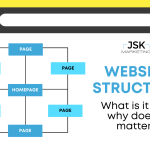
Even if you have had little to no experience with web development, chances are you have heard of SEO (Search Engine Optimization). SEO is a list of techniques that can help your site reach a higher position in search results on Google and other search engines. Some techniques include having detailed and original content, keywords placement on your website, and creating a sitemap. While all of these are important tactics to have for a successful SEO strategy, creating a sitemap is one of the most essential tactics you can do to increase your organic traffic. In this blog post, you’ll find out what a sitemap is, types of sitemaps, and why it is so important to have for your SEO strategy.
What is a Sitemap?
A sitemap is a file that contains your website’s structure, or in other words, the floorplan or blueprint of your website. A sitemap is a full list of all URL’s on your site and makes it easier for search engines to understand your content and where/how to categorize it. There are no known risks of having a sitemap, so creating one and putting it to use on your site will only benefit you.
Why is a sitemap important?
Have you ever wondered how Google finds websites and decides how to rank them? Google uses a bot to explore the content on your site, moving from page to page. Along the way, it records the information and links being used. Google uses the data that it has gathered to create search results to determine what searches a particular piece of content is most relevant for. Since tracking your organic traffic is crucial to see where your page visitors are coming from, it is necessary for Google to understand your site, and that is where site maps come in to play.
Types of Sitemaps
- XML Sitemaps
These sitemaps are usually used for larger websites. They help Google and other search engines discover and navigate your website. A website URL is provided to search engines and offers a complete map of all your pages that they will in turn use to help prioritize for organic searches. Since these are used for bigger sites, the search engine cannot crawl the entire site at once, so this gives the search engine a list of pages to prioritize.
- HTML sitemaps
These are used on smaller websites and can usually be found on the bottom footer of the page. Since these sitemaps are smaller, they can be crawled in its entirety. These are more beneficial for users and provides an overall simpler experience when visiting your website.
Sitemaps are essential when it comes to your businesses’ SEO rankings, SEO strategy, and tracking organic traffic. Sitemaps have many SEO advantages, including helping Google to understand how often you are changing your pages so that the rankings can be updated accordingly; it also allows users to navigate through your site with ease. If you haven’t begun working on your SEO strategy yet, or are unsure of where to start, contact us today. We would be more than happy to help!




